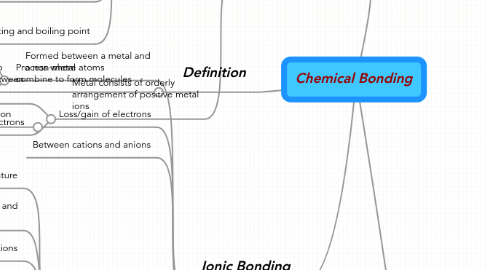
1. Ionic Bonding
1.1. Formed between a metal and a non-metal
1.1.1. Metal atoms lose valence electrons
1.1.2. Non-metal atoms gain valence electrons
1.2. Loss/gain of electrons
1.2.1. To attain octet configuration
1.3. Between cations and anions
1.4. Compounds formed
1.4.1. Solid at room temperature
1.4.2. High melting point and boiling point
1.4.2.1. Strong force of attraction between molecules
1.4.3. Forms positive and negative ions
1.4.4. Conduct electricity when molten or aqueous
1.4.4.1. Dissociation of compound in solutions allows free movement of electrons
1.4.5. Giant ionic lattice
1.4.5.1. Electrostatic interaction between positive and negative ions
1.4.6. Usually water soluble
1.5. Simple or complex ions
1.5.1. Simple ions
1.5.1.1. Formed when an atom of an element loses or accepts electrons to form a charged particle
1.5.2. Complex ions
1.5.2.1. Is a charged particle that consists of more than 1 atom of 1 or more elements
2. Covalent Bonding
2.1. Formed between 2 non-metals
2.1.1. Both atoms need to gain valence atoms
2.1.1.1. Both atoms share valence electrons instead of trading
2.2. Sharing of electrons
2.2.1. "Shared" electrons travel around the nuclei of both atoms
2.2.1.1. To attain octet configuration
2.3. Simple molecular
2.3.1. Compounds formed
2.3.1.1. Often liquid or gas at room temperature
2.3.1.2. Low melting point and boiling point
2.3.1.2.1. Weak intermolecular forces
2.3.1.3. Exist as neutral molecules (No ions)
2.3.1.4. Do not conduct electricity when molten or aqueous
2.3.1.4.1. Compound remains as same molecule in water and does not allow for free movement of electrons
2.3.1.5. Can form multiple bonds
2.3.1.5.1. Equals to eight minus group number
2.3.1.6. Tend to be more flammable than ionic compounds
2.3.1.6.1. Carbon and Hydrogen have similar electronegativities and are found together in most covalent compounds
2.4. Macromolecular
2.4.1. Compounds formed
2.4.1.1. High melting and boiling point
2.4.1.1.1. Strong covalent bonds in structure
3. Definition
3.1. Process where atoms combine to form molecules
3.1.1. Each atom attains octet configuration
4. Metallic Bonding
4.1. Characteristics
4.1.1. Malleable
4.1.1.1. Layers of atoms can slide easily over one another
4.1.2. Hardness
4.1.2.1. Pure metals are weak and soft
4.1.2.2. Alloys are much harder
4.1.2.2.1. Alloys are mixtures of metals
4.1.2.2.2. Orderly arrangement disrupted by atoms of another metal
4.1.3. Good electrical conductors
4.1.3.1. Electric current consists of moving electrons
4.1.4. High melting and boiling point
4.1.4.1. Molecular bonds are strong and hard to break
4.2. Metal consists of orderly arrangement of positive metal ions
4.2.1. Electrons free to move about between ions
4.2.2. Surrounded by sea of electrons
